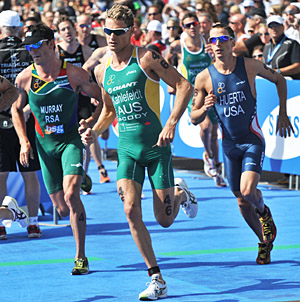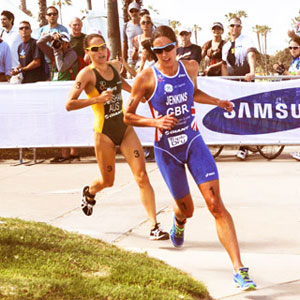Aussies’ Choice
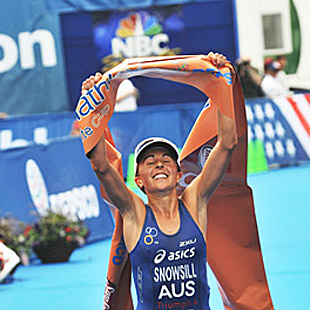
Australian women have won 13 of 22 International Triathlon Union Olympic distance World Championships (best by far) and 4 of 9 triathlon medals at the Olympics. Australian men have won 6 of 22 ITU World Titles (second to Great Britain’s 9). So why is this triathlon power’s Olympic selection process always a soap opera that incites derisive jokes, endless second guessing and occasional lawsuits?
In comments on Australia’s popular Firstoffthebike.com discussion forum, Triathlon Australia’s Olympic selection process was deemed “a total joke,” “just stupid,” and roasted as “the faceless TA charlatans who are ‘organizing’ this are killing the sport and making triathlon a joke.” While the phraseology is overheated and oversimplified, it is safe to say that everyone has a gripe.
The U.S.A.’s Hunter Kemper, after he and Manny Huerta met the U.S.’s clear cut standard for automatic Olympic qualification by finishing in the top 9 at San Diego, said of the Aussie system: “I am glad we settled it on the race course. When it gets to committees it gets very sketchy. Triathlon Australia will have a hard time. Let the athletes decide.”
With all that talent, why does Triathlon Australia create so much angst in their Olympic selection process? To Greg Bennett, who placed 4th for Australia at the 2004 Olympics, the answer is: “Australia has too many great athletes competing for just three spots.” A more complicated answer is that with such abundant talent, Aussie selectors have a correspondingly great fear of failure. Since their home country Olympic triathlon 12 years ago in Sydney, Aussie selectors have tried to balance the simplicity of Olympic selection races – a la Australian Olympic swimming – with bet-hedging discretionary picks that take into account history, recent form and gut feelings about who will be hot on the day. In theory this looks like a well balanced investment strategy. But in practice, Murphy ’s Law often prevails.
History
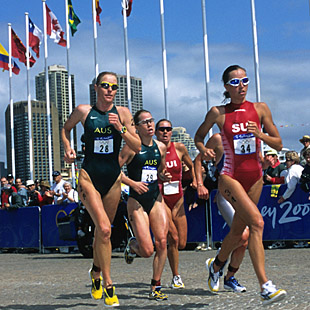
Triathlon Australia’s Olympic selection misadventures begin at the beginning. In 2000, TA decided that the winner of the ITU Sydney World Cup in April would get the first Olympic slots. Dark horse longshot Peter Robertson shocked the world and Australia’s legends by taking the men’s win and short odds favorite Michellie Jones also obliged by winning her race at Sydney. But the fate of 1999 ITU World Champion Loretta Harrop, who was dominating the ITU World Cup scene but was fighting injuries, was a trickier proposition. Through a complex selection rule called Disadvantaged Athlete Exception, Harrop had a path to the team. This rule allowed a temporarily injured star to be eligible for an Australian selectors’ discretionary pick. But competitors could not simply show up with a doctors’ note and hope that their resume would carry the day. The athlete had to start the race but need not finish. Harrop hopped in, swam 100 yards and dropped out – making her eligible to file for a discretionary pick. In the race, two-time World Champ and 1999 ITU Worlds bronze medalist Emma Carney was 4th Australian woman, 13th.overall and, as events would prove, thought the Disadvantaged Athlete Exception wasn’t valid.
In the next Australian Olympic selection race two weeks later – the 2000 ITU World Championship at Perth – Nicole Hackett won and took the second automatic Australian slot, thanks in part to an egregious miscue by organizers who flagged the race after three of four scheduled run laps and saved her rapidly diminishing lead over fast closing Carol Montgomery.
After Hackett, Jones underlined her Olympic status with a 3rd place finish and Carney improved to second Australian and 7th overall. After the race, Australian selectors exercised their discretionary pick and named Harrop to the team, valuing her more recent world title and current world number one ranking over Carney’s 1994 and 1997 World Championship golds and her 1999 bronze. Carney filed suit, which eventually went to the Court for Arbitration of Sport, which denied the claim.
After Robertson earned the automatic election and Craig Walton earned the second slot with a 3rd place at the Perth World Championship, TA also exercised a discretionary pick to name Miles Stewart, the 1991 ITU World Champion and 1998 and 1999 ITU World Championship bronze medalist, to the team based on his big race history. Like Harrop, Stewart also qualified for the disadvantaged athlete exception, citing tonsillitis. He too dove in for the start at Sydney to qualify, then dropped out. Like Carney, Greg Bennett filed a protest and hired a lawyer, asserting that his 3rd Australian and 10th place at Perth deserved the third spot on the Olympic team. When his protest with Triathlon Australia failed, Bennett dropped his case.
In the Olympics, Stewart took 6th, Walton 27th and Robertson 34th. Past and future Australian stars Brad Beven, Greg Bennett, Chris McCormack and Courtney Atkinson sat on the sidelines and must have imagined they would have done better. The women fared better as Jones took an inspiring silver and Harrop’s 5th and Hackett’s 9th place put three Aussies in the top 10.
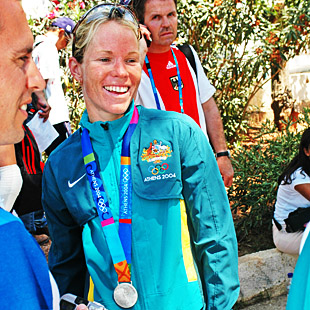
In 2004, Triathlon Australia’s Olympic selection looks bad in retrospect as they left off 2003 ITU World Champion Emma Snowsill and Michellie Jones, the 2000 Olympic silver medalist and winner of the 2003 Olympic test race on the Athens course.
TA scheduled two 2004 Olympic selection races – with hilly courses chosen to reflect the steep hills waiting in Athens. Just two weeks after the early December 2003 World Championship in Queenstown, Loretta Harrop won the first selection race in Coffs Harbour to earn the first automatic spot. The 2003 Junior World silver medalist Maxine Seear was second, and Snowsill, not fully recovered after her first ITU Worlds gold, was 3 seconds back in 3rd. In the next Olympic selection race at Perth in February 2004, Seear won with Rina Hill second, and Snowsill was 4th. Because newcomer Seear had not been named to Australia’s Shadow Team [the term for the athletes under Olympic consideration], Shadow Squad member Hill was granted the second automatic Olympic spot. With one spot left open, the selector’s discretionary pick went to the inexperienced youngster with the hot hand — Seear. Michellie Jones, who had been hampered by injuries, did not qualify for the discretionary pick offered to Harrop four years before and she and Snowsill both missed the team.
In the 2004 Australian men’s Olympic chase, newcomer Simon Thompson won both Olympic selection races. Greg Bennett finished 2nd at Perth and earned the second automatic spot, while Craig Walton, who finished 2nd at Coffs Harbour, was left off due to priority given the second race in the selection criteria. Peter Robertson failed to crack the top 10 in both races, but selectors picked him based on career record — two golds and two silvers at the past four ITU World Championships.
At Athens, Harrop took silver, Hill was 33rd and Seear DNF’d. In the men’s race, Bennett took 4th, with Thompson 10th and Robertson 24th. In retrospect, leaving off super cyclist Craig Walton, who could have crushed Athens’ mighty hills, and Michellie Jones, who had already mastered the Athens course, were two big mistakes.
Australia’s 2008 Olympic selection process had no real controversy among the women, as Emma Snowsill took gold, Emma Moffatt the bronze and Erin Densham was 22nd. The men’s team was embarrassed as failure to garner enough national Olympic qualifying points reduced the Australian men to two slots, leaving off third choice Greg Bennett. On the big day, Courtney Atkinson took 11th and Brad Kahlefeldt 16th.
Right now
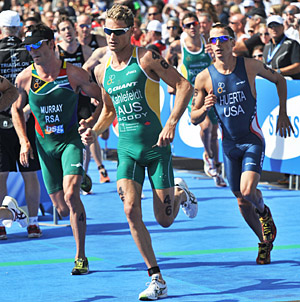
A week before Triathlon Australia has to nominate its final Olympic triathlon team and roughly 11 weeks before the big event, four of the potential six slots are officially up in the air. Emma Moffatt and Brad Kahlefeldt are on the team. But, typical of the Australian process, even these two stars have given Australian selectors some reasons to sweat.
Kahlefeldt was hit with a tuberculosis scare after San Diego and remains weakened by lesions found on his lung after the race. While Moffatt has arguably been playing it smart and waiting to peak in August, she finished 15th in London, 13th at Sydney, and 9th at San Diego. After dominating the World Championship Series for two years, Moffatt plateaued and slipped to 7th — and second Australian — in 2011 ITU World Championship Series rankings.
But the real anxiety comes with the final four slots. Last summer, the Australian women’s team seemed settled with a 1-2-3 finish at the Hamburg WCS event by the Three Emmas – Moffatt, Jackson and Snowsill – in that order. Moffatt with her two recent world titles was obvious. Jackson, a 21-year-old comet with a world class run, was on her way to first Aussie and 4th in the year-long World Triathlon Series and 4th place and top Aussie at the first Australian 2012 Olympic selection event in London.
Snowsill’s career loomed over all of them with her three ITU World titles, two Hy-Vee wins, three Life Time Fitness victories, an ITU Grand Final win and Beijing gold. And her recent form – fifth place and second Aussie at London — looked reasonable a year out.
But what sparked confusion was an unrealistic high bar set for their Olympic selection in the 2011 London event. While Triathlon Australia set the bar that high for the 2000 Sydney World Cup Olympic selection race, this crop of Aussie women were not on form to match those expectations and their men did not have the talent to meet that unforgiving standard. Great Britain, with the dominant Brownlee brothers favored to go 1-2 in the Olympics and Helen Jenkins on target for a second World title, was the only nation justified in demanding that that high a bar for automatic qualification for the 2012 Olympics. And Great Britain only required a top three finish at the 2011 London WCS [Alistair Brownlee was 1st and Jonathan 3rd, and Helen Jenkins won the women’s event].
Triathlon Australia one–upped that by requiring a win at the 2011 London event and a top 3 WCS series finish. Meanwhile, other contending countries happily set a lower bar. Germany required just a top 12 finish at London and defending Olympic champ Jan Frodeno benefited; the U.S. demanded a top 9 and Gwen Jorgenson and Sarah Groff cashed in at London and Laura Bennett, Hunter Kemper and Manny Huerta punched their tickets to London at San Diego.
When all of the Australian triathletes struck out at London, there was effectively no objective Plan B. Triathlon Australia’s remaining Olympic slots then defaulted to the discretion of selectors. Their policy did set out nine criteria to be taken into account, which , for example, optimistically sought a sub-30 minute 10k for the men and sub-33:30 run split for the women. Mixing these guideposts effectively ruled out objective standards and, as selection board member Michelle Gallen said, “without limiting [the selectors’ committee’s subjective choices] in any way.”
Back in November, the Australian Olympic selection committee had nominated Emma Moffatt and Brad Kahlefeldt for the Olympic team and they were approved by the Triathlon Australia Board. Clearly those choices leaned more on records over the last two years than recent form. The plan was then to weigh heavily performance at the Sydney World Triathlon Series opener in April – and then nominate the four remaining slots in plenty of time for the team to prepare for the Olympics.
One complicating factor was that the Australian men were in danger of losing their third Olympic start. Courtney Atkinson, once the Aussie men’s leader in Olympic qualifying points, had not started many races and had become the 3rd Australian behind Kahlefeldt and Brendan Sexton in Olympic qualifying points. And Atkinson’s total was threatened to be passed by the third ranking men from Canada and Portugal – which would displace Australia from the top 8 nations and limit the Aussie men to 2 Olympic starters. No other Australian man was close. With all the leverage, Atkinson refused to start at Sydney – which made selectors very nervous.
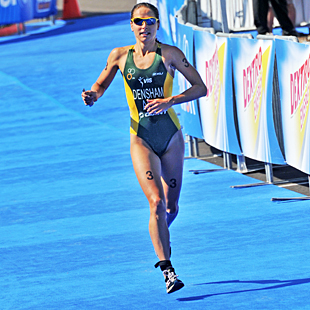
The Sydney WTS event was a jarring rebuke to selectors’ expectations. Erin Densham, who had heroically come back from the dread supraventricular tachycardia heart condition that threatened her career until a December 2009 operation put her back on track, destroyed the field at the Mooloolaba World Cup. She then did the same thing at the high pressure Sydney WTS. Second Australian woman at Sydney was young Ashleigh Gentle, who came 10th. Now-secure Olympian Moffatt cruised to 13th place, Snowsill. 14th, and the 2011 phenom Emma Jackson was 33rd with a disappointing 36:50 run.
The Australian men’s performance was a disaster. Kahlefeldt and Brendan Sexton, the top two ranked men, DNF’d. The top performer was 34th place finisher Chris McCormack, whom many thought was angling for an Olympic third man domestique role. While Macca posted the fastest bike split, he lagged by 40 seconds in the swim and 2 minutes on the run. Following him were Aussies Peter Kerr 40th, Ryan Baillie 45th, Ryan Fisher 46th.
Despite this dismal day in Sydney, the Australian Olympic selection committee had pledged to nominate the remaining four spots on the team immediately. After intense deliberations, the committee presented their four nominations and the Triathlon Australia review board rejected them twice. At that point, Michelle Gallen, the chair of the Triathlon Australia Elite Selection Committee for the past several years and a Director of Triathlon Australia tendered her resignation.
By then, TA board member Antony Beven replaced Gallen and headed a selection process that would measure performances at San Diego and Madrid before the May 31 Olympic selection deadline. Throwing Madrid into the mix might protect the selectors’ posteriors – but likely would leave contending athletes completely thrashed and trashing their hopes for a medal in London.
By then, the selection was beset with paralysis by analysis and radically shifting tides of form that San Diego did little to clarify. Perhaps the only clear sign on the Australian horizon was Erin Densham’s 2012 dominance. At San Diego she extended her incredible streak of peak performances to the breaking point with a second place finish to Helen Jenkins. Moffatt improved slightly with a 9th place finish, just 15 seconds better than the 10th place finish by 21-year-old Ashleigh Gentle. Emma Jackson rebounded from Sydney with a 14th place finish, but nothing resembling her scintillating 2011 form. Snowsill’s 17th place finish was decent but her swim was 33 seconds off, her bike almost 2 minutes back, and her run was 90 seconds down.
On the men’s side, Courtney Atkinson finished 13th and perhaps delivered just enough to stave off Portugal (if not Canada) and hold on to Australian men’s three Olympic slots. Kahlefeldt finished 26th, which turned out to have been a remarkable performance when it was revealed he was hospitalized after the race with lesions on his lung and tuberculosis was feared [he later tested negative for tuberculosis but remained weakened].
Not a good sign for Aussie Olympic medal hopes.
Once again, Chris McCormack gave his all and finished 30th. Throwing the biggest wrench into expectations, Brendan Sexton, who had blossomed in the past year with a 4th at 2011 Sydney, a 2nd at Mooloolaba with a 30:39 run, a win at the Monterrey World Cup and a win at the 2012 Oceania Championship, followed his Sydney DNF with a dispiriting 56th place finish.
The looming decision
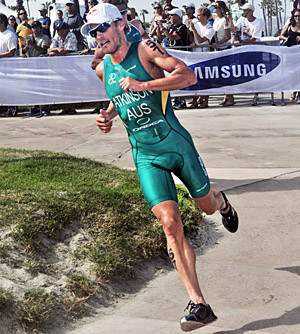
In one of the few signs of sanity, Triathlon Australia decided not to wear out their Olympic hopefuls further with a forced encore at Madrid. Only Brendan Sexton and Emma Jackson, looking to redeem their fading 2012 form, will start.
So where does this leave Australian selectors?
On the men’s side it leaves Aussies hoping that Brad Kahlefeldt and his three ITU World Championship medals, a Commonwealth Games gold and several World Cup wins recovers quickly.
Australia faces tough choices for the men’s team. Do they pick the potential excellence of Courtney Atkinson, despite his resemblance to Achilles, the reluctant warrior of the Iliad? Do they believe that the mercurial talents of Brendan Sexton will be on or off come August? Will Australian selectors reward 39-year-old Chris McCormack’s noble efforts to regain his youthful speed and reap the benefit of his worldwide popularity?
On the women’s side, Miss Moffatt is in and several influential Australians have said that if Erin Densham is left off the team after her dominant spring, there would be an angry revolution. That leaves one slot.
On the one hand, selectors can pick the single greatest female Olympic-style triathlete in history. The 30-year-old Snowsill has an unmatched record and has posted the fastest 10k runs under pressure in ITU history. Going against her is a recent slump beginning with an energy-robbing glandular fever and a hip injury in late 2009-early 2010 that severely impacted her racing and training.
The last time she was at full power, she won the 2010 Hy-Vee World Championship Series race and the 2010 ITU WCS Grand Final in Budapest. Last year Snowsill started slow with a 42nd place at Sydney and 21st in Madrid before hitting a decent stretch where she took 3rd at Hamburg and a 5th at London. This year she finished 14th at Sydney and 17th at San Diego with slow swims and catch up bike splits which left her unable to unleash her killer run.
In the face of those uninspired results is the haunting memory of the Australian women left at home – most particularly Michellie Jones and Emma Snowsill in 2004 in favor of a 20-year-old phenom who won the trials but failed at the Olympics.
Still, Australia must consider 20-year-old Emma Jackson and 21-year-old Ashleigh Gentle. Jackson, who has a sizzling run that recalls the young Emma Snowsill, won the 2010 ITU Under 23 World Championship, then exploded on the elite scene in 2011 with a second place in the middle of the Three Emmas at WCS Hamburg, a 4th and top Australian at WCS London, a 4th in the 2011 WCS yearlong series and a win at the 2012 Oceania Championship before fading at Sydney and San Diego.
Gentle also has a topflight run and won the 2010 ITU Junior World Title. In 2011, she won the Mooloolaba ITU Oceania Cup, the Edmonton ITU World Cup, placed 9th and third Australian woman at WTS London. In 2012, she was 2nd at the Oceania Championships, and 10th at both Sydney [2nd Australian woman] and San Diego [3rd Aussie woman].
Odds are the team will be Moffatt, Densham and Snowsill – a duplicate of the 2008 team. If anyone deserves a break it is Snowsill who has proven her brilliance over a decade. If Jackson hadn’t fallen in a slump, and Gentle had won a few bigger races, the choice would be tougher. Ultimately, young guns Jackson and Gentle will have other chances.
But every four years, you can count on Triathlon Australia to write new chapters in their long-running Olympic selection soap opera.


